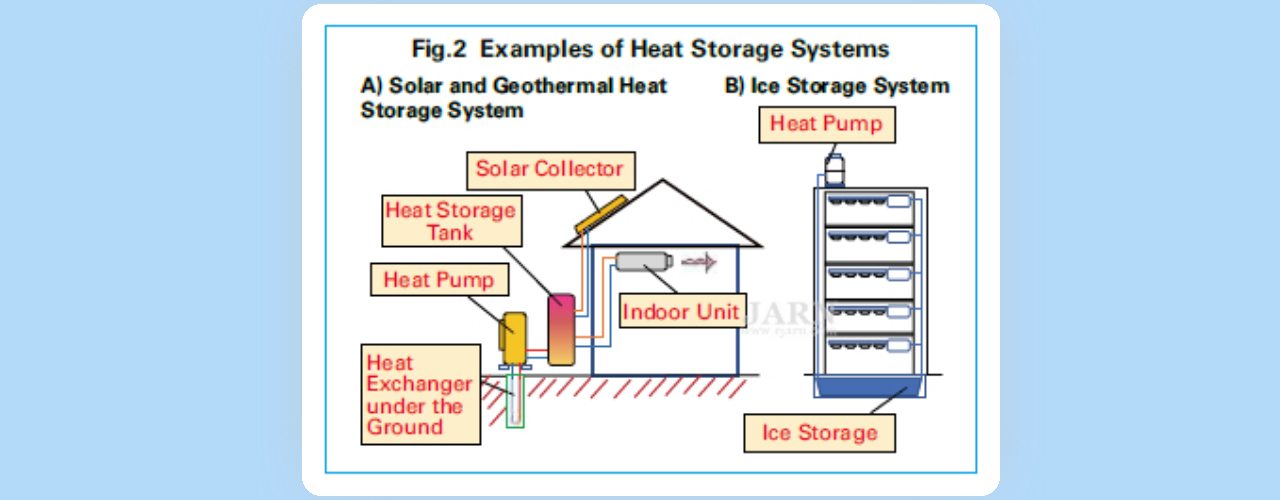
Introduction
Heat pumps are rapidly expanding as an effective means of preventing global warming and promoting carbon neutrality as heating equipment that can replace fossil fuel combustion equipment. The efficiency of heat pumps has been improved, but the rise in efficiency has slowed down. As a measure to further improve the efficiency of heat pumps, uses of efficient heat transfer and heat storage, in addition to improving the efficiency of the equipment itself, can provide efficient cooling, heating, along with hot water supply when needed and with the desired quantity of hot water.
Advantages of Heat Storage
Heat storage is the storage of thermal energy and the ground and water surfaces can be said to be large-capacity heat storage materials because they store solar and atmospheric energy. Heat storage has many advantages as follows.
The capacity of the heat source equipment can be reduced, and it is possible to offset the temporal imbalance of heat use, thanks to the use of a large amount of heat, which is stored with a small capacity, at the time of maximum demand.
Electricity consumption can be leveled between nighttime and daytime, thanks to storage of heat by using electricity at night when electricity consumption is low, and use of the heat during daytime operation to reduce electricity consumption.
Efficient operation can be realized, thanks to the utilization of the temperature difference between day and night as well as heat storage. For example, in the summer, at night when the temperature is lower than during the daytime, ice heat is efficiently stored, then is used for cooling during the day to lower the condensation temperature for efficient operation.
Comfort can be improved, thanks to the installation of a heat accumulator in the outdoor unit of the heat pump. For example, the heat can be used to prevent the room temperature from dropping during heating due to defrosting operations, and to blow out warm air quickly at the start of heating operation.
The use of renewable energy such as solar, geothermal, and factory waste heat is becoming easier, thanks to the use of heat storage.
Heat Storage Types
There are various methods of heat storage.

Sensible heat storage is a method that stores thermal energy by making use of temperature changes in liquids such as water and solids such as bricks and concrete, and is widely used. For example, the sensible heat storage method with water is used for air-to-water (ATW) heat pumps for water heating and space heating. Taking concrete buildings as an example of the sensible heat storage method with concrete, their ceilings, floors, walls, etc. are used as heat storage materials. Since sensible heat storage has a relatively low heat storage density, the heat storage amount is increased by expanding the temperature difference of the heat storage material.
Phase-change heat storage or latent heat storage is a method of storing heat with the thermal energy dissipated or absorbed when a substance changes into a solid or liquid, and has a higher heat storage density than sensible heat storage. An example of the use of phase-change heat storage is thermal storage air conditioning systems that use the latent heat generated by the phase change of water and ice. Another example is heating equipment that uses paraffin with a large amount of latent heat as a heat storage material to improve performance. In addition, phase-change heat storage functional polymers, resins with heat storage properties, are used as insulation materials for floor heating in houses.
Chemical heat storage is a method of storing and dissipating heat generated by a chemical reaction that is triggered when the reaction medium and the heat storage material come into contact with each other. If the reaction medium and heat storage material are separated, the heat storage state can be maintained for a long period of time. However, since the reaction temperature for generating heat is higher than 200℃, research and development (R&D) such as utilization of factory waste heat with high temperatures is underway.
Systems Using Heat Storage

Systems that use heat storage come in various forms and methods, such as ATW heat pumps for water heating and space heating, ice thermal storage systems, and building structure thermal storage air conditioning systems. The development of heat storage utilization systems combined with the use of solar energy, geothermal energy, factory exhaust gas energy, etc. is also being actively carried out, and many new heat storage systems have been reported.
Heat Storage Issues
Heat storage has many advantages, but it also presents challenges. The first is heat loss. The second is the difference in the heat exchange temperature between the storage periods and heat removal, which is necessary but leads to a decrease in efficiency. The third is the need of equipment, spaces, etc. for heat storage, such as storage tanks and pools. It is important to address these challenges to make heat storage easier to use and more effective.

For example, in order to reduce the heat dissipation loss mentioned as the first issue, it is important to insulate the heat storage container. Therefore, various heat insulation materials such as rock wool, glass wool, polyethylene foam, urethane foam, and vacuum insulation have been developed. These heat insulating materials are required to have heat resistance, moisture resistance, durability, etc., in addition to heat insulating performance. Among them, the vacuum insulation material is said to be an ideal insulation material, and it is being used for hot water tanks, heat storage containers, and houses as it is being made thinner and the cost is decreasing. Thermal insulation of houses and buildings is also an important issue that is related to the heat load of air conditioning.
Conclusion
Modern society consumes a large amount of energy, and the accompanying large amount of waste heat is causing global warming. As a countermeasure, it is essential to develop a system that utilizes the waste heat energy generated, along with improving the energy efficiency and reducing energy consumption. Heat pumps and heat storage are technologies that realize these objectives, and further R&D is expected.
Important development themes are quick heat transfer during heat storage in a container and dissipation from the container with less loss, and higher heat density of heat storage. If a compact, large-capacity, and inexpensive heat storage system can be realized, its applications will expand greatly. If heat pumps using such improved heat storage systems are realized, new systems may be created, just as electric vehicles and drones have been created using high-density batteries.
Post time: Jun-28-2023








